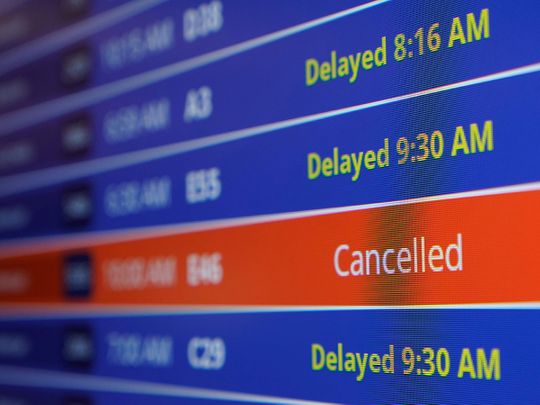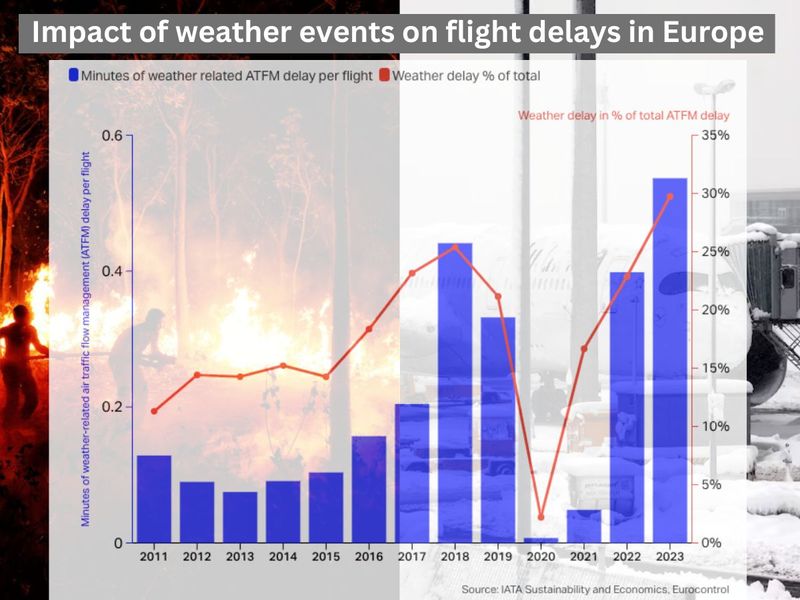
When it comes to the weather, the only certainty is its unpredictability.
Still, prospective air travellers should take heed: Recent industry data indicate that increasingly severe and unpredictable weather phenomena may persistently hinder flights.
This is particularly so for flights in and out of Europe, according to an International Air Transport Association (IATA) report on Sunday (March 31, 2024).
Citing 2023 data from the European Severe Weather Database, the industry group cited an 18 per cent uptick in reports of sizable hail and intense rainfall compared to the previous year as an area of concern for both airlines and travellers.

Record high, disruptive hailstones
This surge in severe weather instances not only marked a record high for hail occurrences – but also noted larger and more disruptive hailstones, as confirmed by the European Severe Storms Laboratory.

Failure to address these shifting weather patterns could exacerbate flight disruptions, presenting a growing concern for travellers, IATA stated in a recent report.
This challenge underscores the necessity for airlines to boost operational adaptability alongside measures to address climate change, the Montreal-based association stated.
Changing weather patterns
“Weather patterns have been changing, directly impacting airline operations, as evidenced by recent trends in the Air Traffic Flow Management (ATFM) delays in Europe,” said the industry group.
In such cases, aircraft are asked to delay their take off by several minutes, or slightly alter their flight paths.
ATFM delays – defined as a lack of capacity in specific airspace areas – is blamed on increasing frequency of disruptive events such as natural (severe weather) causes and airspace closures. The 2020 pandemic is another example of a rare unforeseen factor in ATFM delays.
Contingency planning
IATA urged airlines to place greater emphasis on resilience and contingency planning.
“Robust contingency measures, redundancy mechanisms, and crisis management protocols are essential to ensure the continuity of air traffic operations during unforeseen events,” it said.
Longer delays
The average delay rose from 0.13 minutes per flight in 2011 to 0.54 minutes in 2023. In total, this amounted to 5.4 million minutes – or 90,000 hours of flight delays last year, IATA stated.
“This has a cost impact on airlines, travellers, and the environment,” the recent industry report stated.
90,000
Number of hours of flight delays last year (5.4 million minutes)“Although the average delay per flight is low, it is important to recognise that a relatively small number of flights are affected by weather.”
The shortest average weather-related delay across the airspace covered by Eurocontrol was observed in 2020 – when COVID-19 caused low traffic volumes – which meant that there was sufficient airspace capacity to absorb any disruptions.
Spike in airport-level weather delays
Additionally, IATA stated, this data does not capture airport-level weather delays, which have further significant operational and cost impacts on both passengers and the airlines.
Weather delay as a proportion of the total delay increased from around 11 per cent in 2012 to almost 30 per cent in 2023.
Escalating volatility
Last year (2023) witnessed numerous unprecedented weather occurrences, with 25 confirmed weather-induced disasters causing losses surpassing $1 billion, as reported by the National Oceanic and Atmospheric Administration. From devastating tornadoes in the southern regions to haze-filled skies, atmospheric rivers, blistering heatwaves, and super-fog, 2023 showcased a spectrum of escalating weather volatility.
2023 warmest year on record
Extreme weather is also be seen in weather data a recently disclosed numbers solidified 2023 as the warmest year on record, marked by an exceptionally scorching summer that propelled the global mean temperature to more than 2.5 degrees F above average.
North America not spared
The frequency of hot days and heatwaves across North America has also surged, with up to six heatwaves annually compared to merely two some 50 years ago.
Additionally, Canada's wildfires introduced wildfire smoke hazards to regions of the United States previously unaffected.
Another remarkable weather phenomenon of 2023 is the emergence of "atmospheric rivers" – elongated bands of concentrated moisture in the atmosphere significantly shaping weather patterns and yielding both beneficial rainfall and detrimental flooding.
Super-fog events
Super fog events also made their mark in 2023, often originating from wildfires. Stemming from a blend of atmospheric moisture and smoke from marsh fires, these events, escalating due to drier conditions, can precipitate abruptly, drastically reducing visibility and catching motorists off guard.
'New normal'
The Atlantic hurricane season of 2023 concluded with above-average activity, witnessing 20 named storms.
This trend of heightened activity has become the norm, with the Atlantic experiencing no below-average seasons since 2015.
However, the sea surface temperatures in 2023 that fueled these storms reached unprecedented levels, particularly notable in the primary region for tropical storm development, which registered the warmest temperatures since the US National Oceanic and Atmospheric Administration (NOAA) started its record-keeping in 1950.
Besides the economic impact, extreme weather events also increasingly pose health risks, displacement and migration, food and water insecurity, infrastructure vulnerability, social disruption, and psychological stress – not to mention their effects on the ecosystem, with far-reaching consequences for human well-being and sustainability.








